In one of the most anticipated matchups of the tournament, Los Cafeteros and La Celeste clashed in Charlotte, North Carolina, to determine who would face Argentina in the CONMEBOL Copa América 2024 Final. Both Colombia and Uruguay had proven their prowess in the matches leading up to this decisive knockout encounter, establishing themselves as two of the best teams in the tournament. Los Cafeteros entered the match as the highest-scoring team, while La Celeste boasted the second-highest goal tally. Defensively, Uruguay was tied for the best record, and Colombia closely followed, tied for the second-best defensive record.
As Marcelo Bielsa’s Uruguay and Nestor Lorenzo’s Colombia stepped onto the pitch under the bright North Carolina sun, the stakes were clear: one team would secure a coveted spot in the final, while the other would be relegated to the third-place match against Canada. The stage was set for a thrilling and tactical battle, with both teams aware of the magnitude of the moment and the fine margins that would likely decide their fate.
The match between Uruguay and Colombia was a riveting encounter that showcased the tactics and resilience of both teams, as we will see in this analysis. The thrilling atmosphere, marked by passionate fans and high-stakes drama, set the stage for a captivating duel. Despite Uruguay’s possession and midfield control dominance, Colombia emerged victorious. This tactical analysis delves into the tactical nuances and statistical data to understand how Colombia managed to clinch the win despite the odds.
Lineups
Under the guidance of coach Nestor Lorenzo, Colombia lined up with a formation designed to balance defensive solidity and attacking flair. Camilo Vargas stood guard between the posts, with a defensive line comprising Johan Mojica, Carlos Cuesta, Davinson Sanchez, and Daniel Munoz. Munoz’s aggressive play would later lead to his dismissal after receiving a second yellow card. Jefferson Lerma provided the anchor in the midfield, flanked by Kevin Rios and Santiago Arias, who offered both defensive cover and forward momentum. Ahead of them, the attacking trio of Liverpool‘s Luis Diaz, Rafael Santos Borré, and the former Real Madrid player James Rodriguez, who was named Superior Player of the Match, spearheaded the Colombian offence. Rodriguez’s set-piece delivery proved decisive, as his perfectly placed corner was met by Lerma’s head for the game’s only goal.
Uruguay, led by the experienced Marcelo Bielsa, opted for a formation emphasising their dynamic and disciplined style. Sergio Rochet was the man in goal, protected by a backline featuring Martin Caceres, Jose Gimenez, and Mathias Olivera. The midfield trio of Manuel Ugarte, Federico Valverde, and Tottenham‘s Rodrigo Bentancur provided a blend of energy, creativity, and defensive cover, although Bentancur’s involvement was cut short due to an injury, prompting Guillermo Varela’s early introduction. Nicolas De La Cruz operated just ahead of them, linking play between midfield and attack. On the flanks, Facundo Pellistri and Darwin Nunez sought to stretch the Colombian defence, with Nunez having several chances but ultimately failing to convert. Maximiliano Araujo completed the starting lineup, plalineup more central role in Uruguay’s attacking efforts.
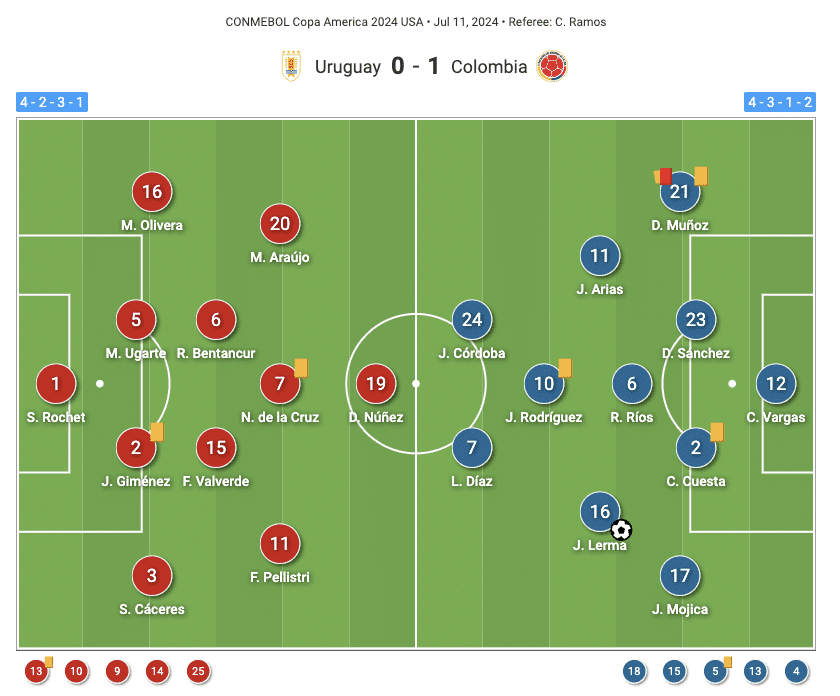
The match saw several strategic substitutions from both sides as the coaches sought to gain an edge. For Colombia, Nestor Lorenzo introduced Diego Arias, Mateus Uribe, Gustavo Castano, Yerry Mina, and Luis Sinisterra. Each substitute aimed to solidify the lead and adjust to the man disadvantage following Munoz’s red card. Uruguay’s Bielsa brought on experienced campaigners like Giorgian De Arrascaeta, Luis Suarez, and Agustin Canobbio to try and breach the Colombian defence.
The referee, Cesar Ramos from Mexico, officiated the game, which saw a flurry of cards as tensions ran high.
Dominating the Game
The match began with both teams testing each other cautiously. Uruguay, with their superior possession statistics (61.8% compared to Colombia’s 38.2%), sought to control the game through methodical build-up play. Darwin Nunez spearheaded the Uruguayan attack, creating multiple opportunities that narrowly missed the target. However, the game took a pivotal turn in the 35th minute when Uruguay lost key midfielder Rodrigo Bentancur to injury, necessitating a tactical switch from a back three to a back four.
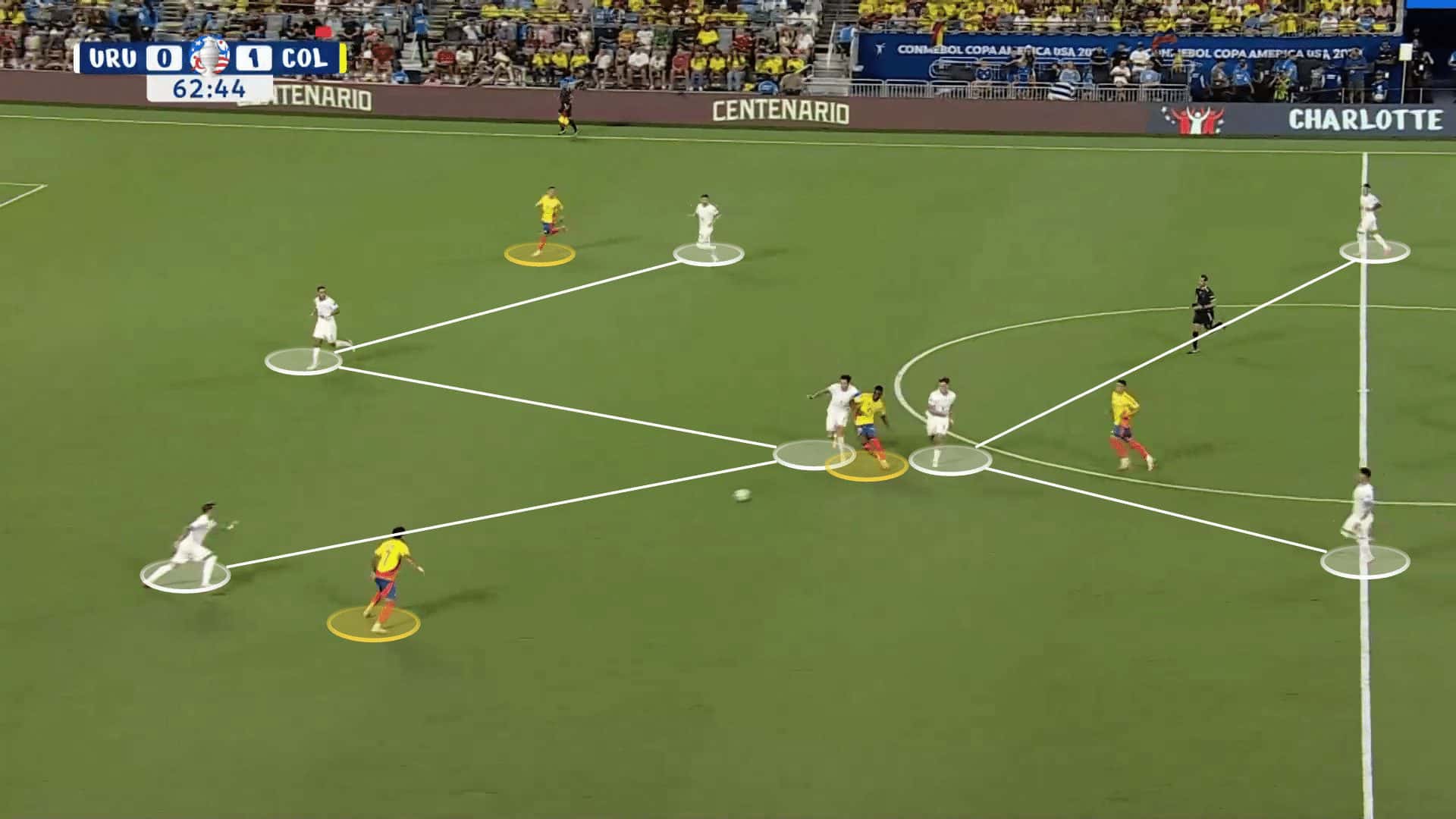
Colombia capitalised on this disruption in the 40th minute. A well-executed set piece, a hallmark of Colombia’s strategy, saw James Rodriguez deliver a precise corner that Jefferson Lerma headed in for the opening goal. This moment not only showcased Rodriguez’s exceptional playmaking skills but also highlighted Colombia’s efficiency in converting set-piece opportunities into goals.
The dynamics of the game shifted dramatically just before halftime when Colombia’s Daniel Munoz received his second yellow card, reducing Colombia to ten men. This setback forced Colombia to adopt a more defensive posture, transitioning to a 4-3-2 formation. This strategic adjustment aimed to maintain defensive solidity while still retaining the potential for counter-attacks through the outlets provided by Luis Díaz and Cordoba.
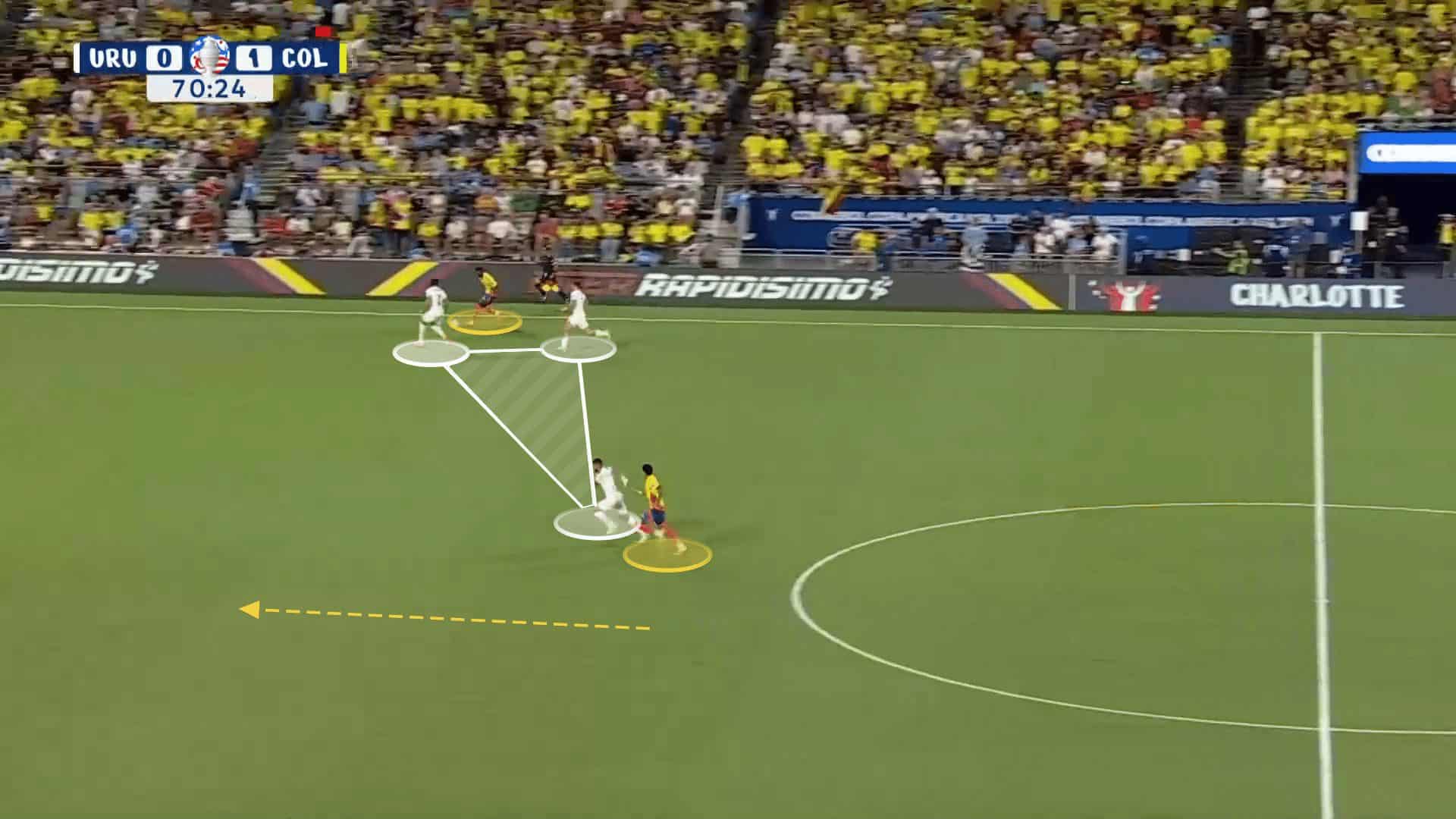
In the second half, Uruguay leveraged its numerical advantage to dominate possession further. Uruguay’s passing accuracy (83.7% compared to Colombia’s 72.2%) and forward passes (281 to Colombia’s 177) underlined its control of the ball and intent to penetrate the Colombian defence. Despite this, Uruguay struggled to break down the resilient Colombian defence, which was compact and well-organised.
Colombia’s defensive strategy was exemplified by their aerial duel success rate (60.0% compared to Uruguay’s 40.0%) and clearances (15 compared to Uruguay’s 7). These metrics illustrate Colombia’s effectiveness in neutralising aerial threats and clearing dangerous balls from their penalty area.
Bad chance conversion
Uruguay’s attacks were met throughout the second half with staunch Colombian defending. Luis Suarez, who entered as a substitute, came close to scoring with a shot that clipped the post, highlighting the fine margins in this tightly contested match. Colombia, despite their reduced possession, created significant chances on the counter, particularly in the dying minutes of the game. Mateus Uribe had two clear opportunities to extend Colombia’s lead, but both were thwarted by Uruguay’s goalkeeper Rochet.
Despite their defensive prowess, Uruguay’s campaign in the knockout stages was marred by a surprising inability to convert chances. During the group stages, La Celeste had been prolific, netting nine goals and topping Group C. Yet, as the competition progressed, their attacking efficiency seemed to wane. This lack of cutting-edge was painfully evident against Colombia.
Darwin Núñez epitomised Uruguay’s struggles in front of goal. In the first half alone, Núñez took all four of Uruguay’s shots but failed to hit the target even once. His efforts were a mix of near-misses and blocked attempts, encapsulating a frustrating night for the Uruguayan forward. Despite being one of the tournament’s standout performers early on, Núñez’s goal drought extended, with his last goal dating back to the 21st minute of Matchday 2 against Bolivia.
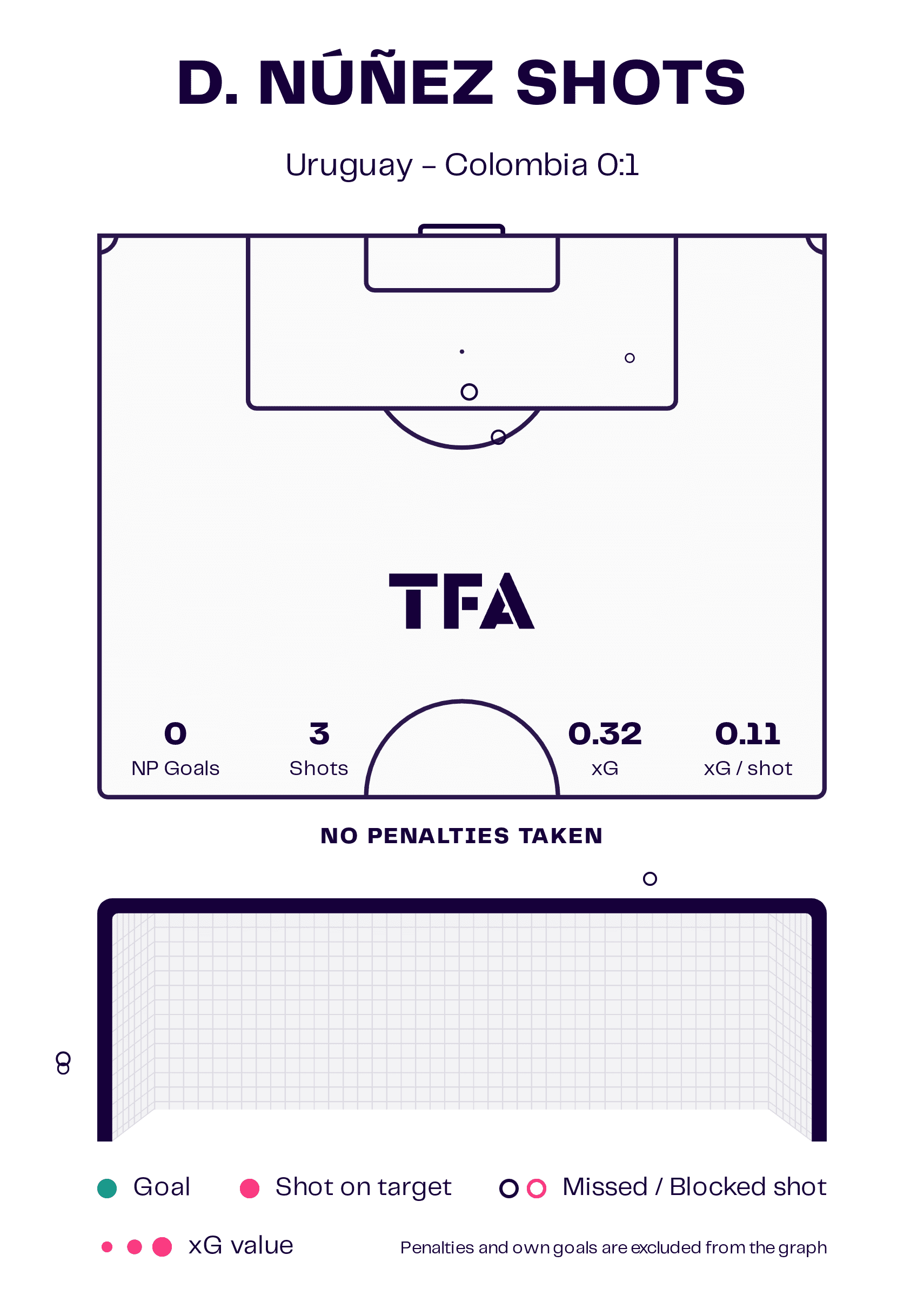
Uruguay’s attacking woes were further highlighted by their inability to capitalise on a numerical advantage in the second half after Colombia went down to ten men. La Celeste managed just two tame shots on target by the time the final whistle blew. Even the introduction of veteran striker Luis Suárez couldn’t break the deadlock. Suárez came agonisingly close, his effort clipping the post, but luck was not on Uruguay’s side.
Switch to a Back-Five
Colombia’s ability to withstand Uruguay’s pressure and exploit counter-attacking opportunities was crucial. Their crossing accuracy (54.5% compared to Uruguay’s 31.8%) and key passes (11 to Uruguay’s 10) indicate their precision in critical moments, making the most of their limited attacking forays.
As the game drew to a close, Colombia’s defensive wall consistently denied Uruguay’s relentless pursuit of an equaliser. The tactical switch to a five-at-the-back formation in the final minutes exemplified Colombia’s commitment to preserving their lead. Luis Diaz’s tireless efforts in chasing down clearances provided a vital outlet, alleviating pressure on the Colombian defence.
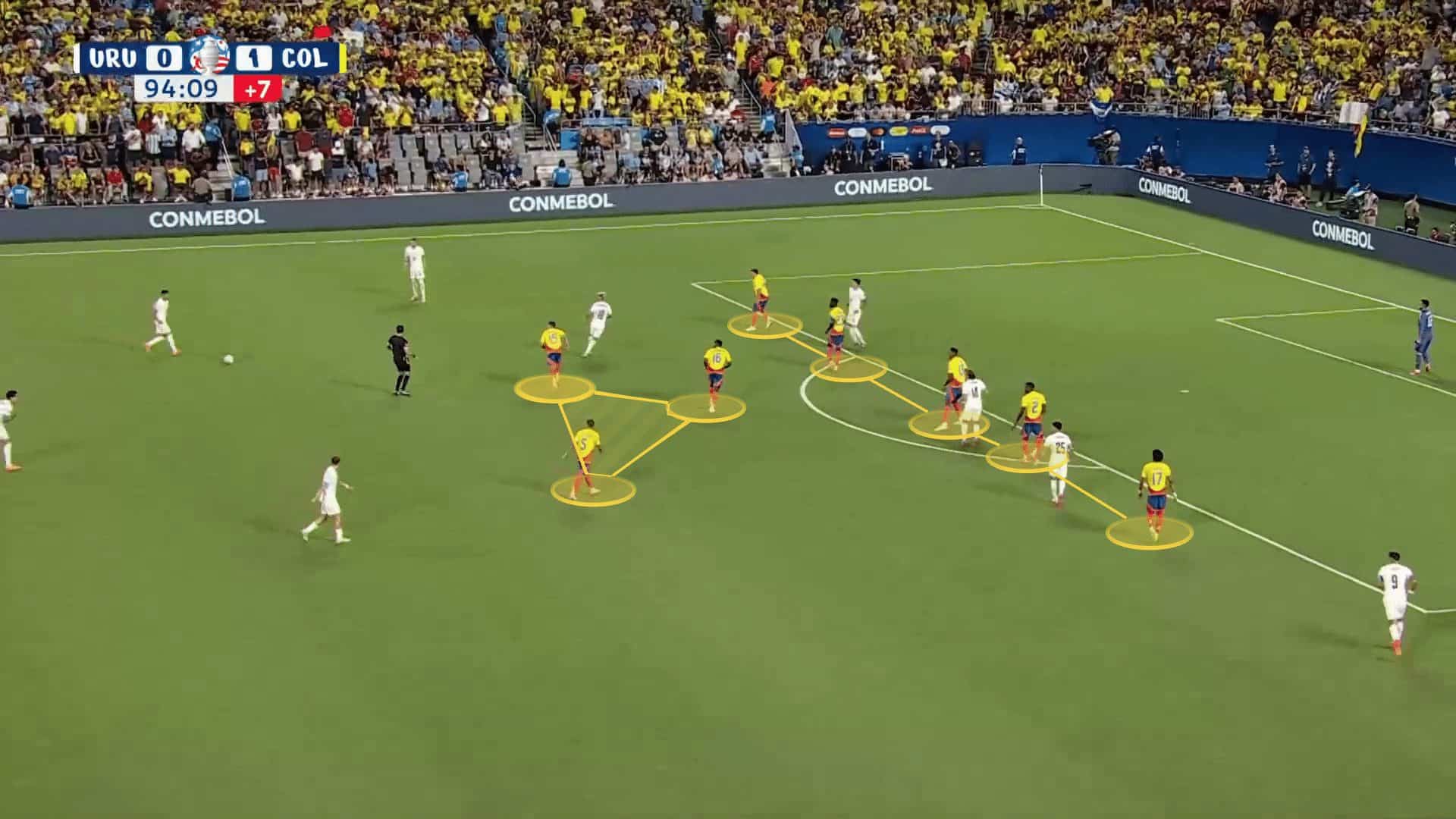
Colombia’s victory can be attributed to their strategic adaptability, defensive resilience, and clinical execution of set pieces. Despite Uruguay’s dominance in possession and passing metrics, Colombia’s ability to capitalise on crucial moments and maintain a disciplined defensive structure proved decisive. This match underscores the importance of tactical flexibility and efficiency in critical phases of the game, qualities that ultimately propelled Colombia to triumph in this high-stakes encounter.
Conclusion
Despite Uruguay’s dominance in possession and numerous attempts to break down the Colombian defence, they struggled with poor chance conversions. Colombia’s disciplined defence, bolstered by Nestor Lorenzo’s tactical acumen and Lerma’s clinical finish off a set-piece by Rodriguez, ultimately secured their victory.
Los Cafeteros emerged victorious, winning 1-0 as the final whistle blew, and it was bedlam for Colombia and heartbreak for Bielsa and Uruguay. Nestor Lorenzo’s team, a squad with now a 28-game unbeaten streak, destined to meet the defending champions Argentina in the Grand Final. Captains James Rodriguez and Lionel Messi battling for another trophy at the end of their careers. The stage is set at Hard Rock Stadium in Miami.
Colombia is headed to Miami Gardens to play Argentina in the Grand Final at Hard Rock Stadium on July 14, while Uruguay will stay in Charlotte to play Canada at Bank of America Stadium on July 13 to determine third place.





Comments